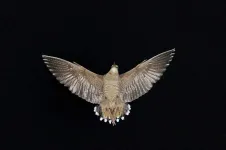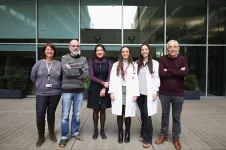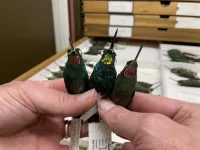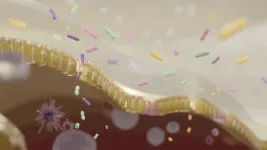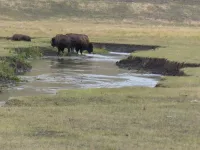(Press-News.org) The mainly brown woodcock uses its bright white tail feathers to communicate in semi-darkness, reflecting 30% more light than any other known bird.
These surprise findings, by a team led by an Imperial College London scientist, suggest there is much to learn about how birds that are most active at night or at dawn and dusk communicate.
Birds that are most active during the day often have colourful plumages, which they use to communicate information with each other. Birds that are most active at dawn and dusk or at night (‘crepuscular’), such as nightjars and woodcocks, tend to have less showy plumage, as while sleeping during the day they need to be camouflaged to avoid predators.
Rather than using showy plumages, it was thought that birds active during low light conditions instead used sounds or chemicals to communicate. However, many have bright white patches, which could be used in environments with very little natural light for communication if these are reflective enough.
The Eurasian woodcock, Scolopax rusticola, is primarily mottled brown, but has patches of white feathers on the underside of its tail. This means it only shows these patches when raising its tail or during courtship display flights.
However, as they are crepuscular, and so most active during low light, these white patches need to reflect as much light as possible to attract attention. To investigate how they might do this, the team studied the white tail feathers of Eurasian woodcock specimens from a collection in Switzerland.
They used specialised microscopy to image feather structure, spectrophotometry to measure the light reflectance, and models to characterise how photons of light interact with structures inside the feather. They were surprised to find the reflectance measurements showed the feathers reflected up to 55% of light – 30% more light than any other measured feather. The results are published today in Royal Society Interface.
Lead researcher Jamie Dunning, from the Department of Life Sciences (Silwood Park) at Imperial, said: “Bird enthusiasts have long known that woodcocks have these intense white patches, but just how white they are and how they function has remained a mystery. From an ecological perspective the intensity of the reflectance from these feathers makes sense – they need to hoover up all the light available in a very dimly lit environment, under the woodland canopy at night.”
Individual feathers are made of a central stem with protrusions called rami forming the bulk of the structure. The rami are held together by round Velcro-like ‘barbules’.
The team found that in the woodcock’s white tail feathers the rami are thickened and flattened, which both increases the surface area for light to bounce off, while also making it less likely light will pass between the feather barbs without being reflected.
There are two main ways surfaces are reflective. ‘Specular’ reflection is when light bounces off a smooth surface, like a mirror. ‘Diffuse’ reflectance scatters light rays in different directions. The thickened rami were found to be made up of a network of keratin nanofibers and scattered air pockets. This creates lots of interfaces that can scatter light, increasing the feathers’ diffuse reflectance.
Analysis of the feathers showed one final trick up the woodcock’s sleeve: the rami and barbules in the white woodcock feathers are arranged to create a venetian-blind-like effect that further enhances the surface area, by sitting at the optimum angle for light reflectance.
Principal Curator of Birds at the Natural History Museum Dr Alex Bond said: “This research is a brilliant combination of using museum specimens and cutting-edge tools to try and understand this phenomenon. Being able to see whether closely related species or species with similar ecology also had these incredibly white feathers was a key bit of figuring out the story.”
END
Woodcocks have the brightest white feathers ever measured
2023-03-01
ELSE PRESS RELEASES FROM THIS DATE:
Marker discovered which shows when a type of skin cancer is preparing to metastasise
2023-03-01
Cells that form cutaneous squamous cell carcinoma tumours prepare themselves to migrate to the lymph nodes to metastasise other organs, and they make changes so that they can survive this process. According to a study led by researchers from the Inflammatory and Neoplastic Dermatological Diseases Research Group at the Hospital del Mar Medical Research Institute, published in the journal Life Science Alliance, these cells stop consuming glucose so that they can survive by using LDL cholesterol molecules, the ...
Conversations about safe firearm storage at purchase can influence use of firearm locks
2023-03-01
Although cable locks – commonly distributed to prevent firearm injury and death – are included in many legal firearm purchases, research shows firearm owners rarely prefer or use these devices.
But a Rutgers study published in Injury Epidemiology found that gun owners who were told about cable locks at the time they purchased the firearm were more than twice as likely to use locking devices than those who weren’t told about cable locks when they made these purchases.
“Simply placing a cable lock in a bag when somebody purchases a firearm likely has minimal impact, but a simple discussion mentioning that a lock was included may make enough of an ...
Daily 11 minute brisk walk enough to reduce risk of early death, say Cambridge researchers
2023-03-01
One in ten early deaths could be prevented if everyone managed at least half the recommended level of physical activity, say a team led by researchers at the University of Cambridge.
In a study published today in the British Journal of Sports Medicine, the researchers say that 11 minutes a day (75 minutes a week) of moderate-intensity physical activity – such as a brisk walk – would be sufficient to lower the risk of diseases such as heart disease, stroke and a number of cancers.
Cardiovascular diseases – such as heart disease and stroke – are the leading cause of death globally, ...
Pink + pink = gold: hybrid hummingbird’s feathers don’t match its parents
2023-03-01
The Pink-throated Brilliant hummingbird, Heliodoxa gularis, has, unsurprisingly, a brilliant pink throat. So does its cousin, the Rufous-webbed Brilliant hummingbird, Heliodoxa branickii. When scientists found a Heliodoxa hummingbird with a glittering gold throat, they thought they might have found a new species. DNA revealed a different story: the gold-throated bird was a never-before-documented hybrid of the two pink-throated species.
John Bates, the senior author of a new study in the journal Royal Society Open Science reporting on the hybrid, first encountered the unusual bird while doing fieldwork in Peru’s Cordillera ...
Researchers identify three intestinal bacteria found in dementia with Lewy bodies
2023-03-01
Dementia with Lewy bodies (DLB), one of the most common forms of dementia, has no cure. Previous studies suggested that gut bacteria, the microorganisms that live in the human digestive tract, play a role in Parkinson’s disease, another neurodegenerative disorder, but the bacteria involved in DLB had not been identified. Now, a group led by researchers at the Nagoya University Graduate School of Medicine in Japan has identified three bacteria involved in DLB: Collinsella, Ruminococcus, and Bifidobacterium. Their findings, reported in npj Parkinson's ...
Scientists find that bison are impacting streams in Yellowstone National Park
2023-03-01
Greater numbers of Bison in Yellowstone National Park may come at a cost to the biological diversity of the important streamside habitats of the Park according to a new report in the journal Ecosphere Bison influences on composition and diversity of riparian plant communities in Yellowstone National Park. Riparian areas (streamside zones) form the interface between terrestrial and aquatic ecosystems and are hotspots of biodiversity and productivity in the public lands of the Western USA. The study findings are that ...
Keto vs vegan: Study of popular diets finds over fourfold difference in carbon footprints
2023-03-01
For those on keto or paleo diets, this may be tough to swallow.
A new study from Tulane University which compared popular diets on both nutritional quality and environmental impact found that the keto and paleo diets, as eaten by American adults, scored among the lowest on overall nutrition quality and were among the highest on carbon emissions.
The keto diet, which prioritizes high amounts of fat and low amounts of carbs, was estimated to generate almost 3 kg of carbon dioxide for every ...
Centuries of whaling data highlight likely climate change effect
2023-03-01
Southern right whales adjusted their foraging grounds over the past 30 years as climate change altered where prey could be found, according to a University of Auckland, Waipapa Taumata Rau scientist.
Dr Emma Carroll, of the School of Biological Sciences, was senior author of a paper which used data gleaned from contemporary whale skin samples along with whaling records stretching back to 1792. Over the past three decades, the whales increased their use of mid-latitude foraging grounds in the south Atlantic and southwest Indian oceans in the late summer and autumn, according to Carroll and dozens of collaborators including lead author Solène Derville, of Oregon State University.
The ...
Long COVID linked to lower brain oxygen levels, cognitive problems and psychiatric symptoms
2023-03-01
Long COVID is associated with reduced brain oxygen levels, worse performance on cognitive tests and increased psychiatric symptoms such as depression and anxiety, according to new research studying the impacts of the disease.
Researchers from the University of Waterloo combined the results of two new parallel studies: a laboratory study involving cognitive testing and imaging of oxygen levels in the brain, and a national population survey of Canadians in 2021 and 2022.
The laboratory study found that individuals who had experienced symptomatic COVID-19 illness performed worse on two computer tasks. One is measuring inhibition and another impulsive decision-making. ...
AI draws most accurate map of star birthplaces in the Galaxy
2023-03-01
Stars are formed by molecular gas and dust coalescing in space. These molecular gases are so dilute and cold that they are invisible to the human eye, but they do emit faint radio waves that can be observed by radio telescopes.
Observing from Earth, a lot of matter lies ahead and behind these molecular clouds and these overlapping features make it difficult to determine their distance and physical properties such as size and mass. So, even though our Galaxy, the Milky Way, is the only galaxy close ...
